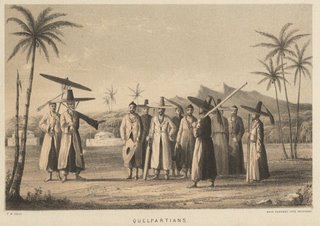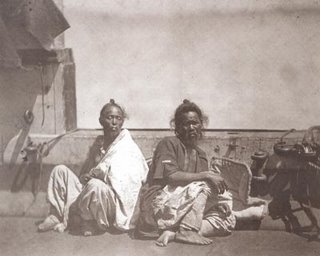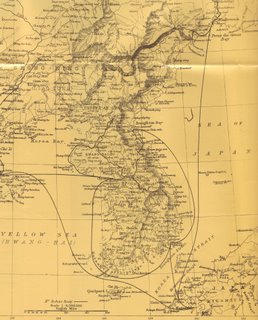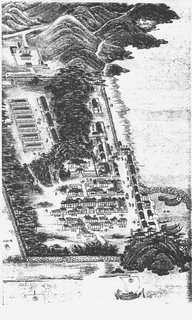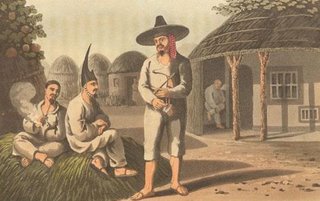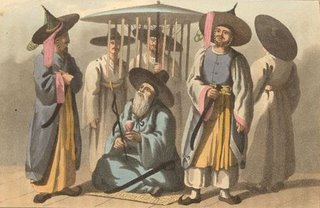The 'Alien Visitors upon Chosun's Shores' series:
Alien Visitors upon Chosun's Shores Part IAlien Visitors upon Chosun's Shores Part IIAn Account of the Arrival of the AudaciousThoughts on the Observations of Conquest-Enabling Explorers
 Japanese troops landing at Chemulpo(Incheon), February 1905
Japanese troops landing at Chemulpo(Incheon), February 1905I've spent the past few weeks describing visits to Korea by foreign ships and the observations made by those sailors in published accounts. In looking at the descriptions of the visits to Korea by Hamel in the 1650s, Broughton in 1797, Hall and M'Leod in 1816, Gutzlaff in 1832, Belcher, Adams and Marryat in 1845, and Bridge in 1875, it's easy to pick out similarities between all of those visits, as well as similarities between the customs of Koreans of those times and Koreans today. Adams, of the 1845
Samarang expedition, covered some of the generalizations which apply to both then and now when he noted that
They are, however, very good-humoured, and seem to enjoy anything like a joke exceedingly. All appear to be passionately fond of spirituous liquors, nor can I say much for their morality of conduct. They are great smokers, carrying continually in their hands a long-stemmed pipe, with a diminutive brass bowl, which they fill and empty at brief intervals.
Speaking of drinking culture,
this article (which led me to Gutzlaff's account), has various descriptions of Koreans' fondness for drinking by foreign sailors. Hall's meeting with a group of islanders in 1816 led him to observe "They have a singular custom of speaking with a loud tone, amounting almost to a shout."
Speaking of speaking, when islanders began to mimic his words, Hall noted that the English words he was teaching them were "pronounced in every instance with perfect propriety. They seemed surprised themselves on discovering powers of imitation hitherto in all probability unexercised." Isabella Bird Bishop made a similar comment in her 1898 book,
Korea and Her Neighbours, saying that Koreans had a "talent for the acquisition of languages, which they speak more fluently and with a far better accent than either the Chinese or Japanese." A
comment by Sewing made me wonder about this description of the islanders' 'perfect' pronunciation. I tend to think one reason so many of my students intone English words incorrectly is due to the way Hangeul structures written Korean. I wonder if one reason (likely) illiterate islanders were able to pronounce English words so well would be due to the fact that they were illiterate and therefore Hangeul didn't have a grip on their concept of pronunciation. Which then raises questions of how Korean (or any language, for that matter) was spoken before literacy became widespread, as well as the influence of literacy in Korea upon English (or foreign) language acquisition and pronunciation.
Such questions might not be very welcomed; to be certain, given the ideas of '
one race' and racial purity students are inculcated with in the school system here, Belcher's comment that "[t]he people themselves appear to be composed of several races", might not get the warmest reception. On the other hand, considering the regional and class divisions which exist in Korea, perhaps some
would welcome his idea that the differences between the 'superior class', military chiefs, officers, soldiers, fishermen, and labourers, were related to 'race'. One of my coworkers seemed to inadvertantly champion that idea when she mentioned her hatred of Japan, and then said that they were all from Jeolla-do originally anyway, which made sense to her as Japanese people and people from Jeolla-do "are all short and and they're all liars" (I still have a bruise where my jaw hit the floor).
Many of the early visitors to Korea after it 'opened' to the west commented upon the harsh forms of punishment to be found in Korea. Almost all of the accounts I've excerpted have described these beatings. Hamel told of how some of his comrades were "each given 25 blows on the bare buttocks with a stick which is about one fathom long and a finger thick at the bottom and round on the top." When Broughton landed, "the military were so stationed as to keep off the crowd, which they did at times most effectually, by exercising upon their persons large bamboo sticks." When one of the islanders annoyed the chief who was visiting Hall's ship, he "gave orders for inflicting the discipline of the bamboo upon the unfortunate culprit". Adams spoke of the use of a "flat baton (formed like an oar and about six feet long), on the bare hams. Many carry about them severe traces of this bastinado practice in the forms of scars and ulcers." Calling to mind Paul S. Crane's comment about Koreans' "ability to survive...under oppression, corrupt governments and foreign invasions", Belcher notes that "It appeared to me to be a most severe punishment, yet the instant the culprit was released he nimbly tucked up his garments and fled, possibly accustomed to this mode of castigation." The tradition of corporal punishment (though not as severe as this) continues to this day
in schools, though it's likely a
little less common than it used to be.
The most glaring similarity between the accounts, however, is the desire of Koreans for their visitors to leave as soon as possible, and conversely, the desire of Korea's
rulers for Korea to be left alone. Hamel noted that the King "doesn't want Korea to be known to foreign countries." Broughton said "we plainly saw they were extremely anxious for our departure", and that they were " by no means desirous of cultivating any intercourse whatever with strangers". Hall wrote that "Their chief anxiety was to get rid of us as soon as possible", and that "They drew their fans across their own throats, and sometimes across ours, as if to signify that our going on [inland] would lead to heads being cut off." Speaking of how the ‘treatment of strangers is regulated’, he wrote
The promptitude with which we were met at this place, where, perhaps, no ship ever was before, seem to imply an extraordinary degree of vigilance and jealousy on the part of the government.
M’leod reflected on the encounter with a chief that he and Hall met:
It was pretty evident, however, that he was acting from orders which he dared not trifle with, rather than from any inhospitable feeling in his own nature; for in this respect there was a manly frankness in the behaviour of all the Coreans we saw, and not what could be considered an inclination to be rude.
We saw enough however, to convince us that the sovereign of this country governs with most absolute sway; and that, occasionally, he makes very free with the heads of his subjects. The allusion to this danger could not have been so constant and uniform, in places so remote from each other, without some strong reason.
Gutzlaff noted that when "one received a book, [he] immediately returned it, exclaiming "pulga," which we interpreted to mean
fire, or
burn it! There was very little chance of giving books in a direct way." Later he noted that
At every place where we afterwards met with Coreans alone, we found them [...] good-humoured and obliging. Thus we ought to ascribe the hostile feelings shown towards strangers, to the iron rules which the government inculcates. We cannot think that those signs of decapitation, made by the people on shore, were merely for pretence, but begin to believe, from the universal adoption of this gesture, that government would punish every transgressor with death, who dared to cultivate friendship with strangers.
Belcher had a similar opinion:
In all their transactions with us, I noticed an irresolution, a fluctuation between violent opposition to our landing in the first instance, and after this act had been consummated, an equal disposition to friendship, clouded by the fear of displeasure from some unseen source.
Bridge, in 1875, also wrote that "The visit of strangers was evidently not much liked. Still the elders showed a certain grave courtesy, and a somewhat pleasing and even well-bred manner." He also noted, as did almost every other sailor, that "Not a woman was visible; all had been carefully hidden away." Anyone familiar with the social position (and physical positioning, so to speak) of women during the Chosun Dynasty will not find that surprising.
Hall, trying to offer gifts to the islanders, found no one who would accept them; however, "one man, [...] as soon as all the rest were out of sight, accepted one of the glasses with much eagerness." Belcher tried to get possibly sensitive information from a man near Quelpart, but "the presence of others, who seemed to act as spies, put an end to our conference." Add these two accounts to descriptions of "the vigilance and jealousy on the part of the government", or "the iron rules which the government inculcates" or "the fear of displeasure from some unseen source", and I can't help but remember Gregory Henderson's comment (made during the period of authoritarian rule) that
In the non-socialist world, I have so far sensed nothing comparable to the South Korean shadowing of the private by the public sphere.
Now, yes, the NIS is nowhere near as 'shadowy' as the KCIA was when Henderson wrote this, and there is no longer a monarchy chopping off heads for talking to foreigners, but what if we replace the KCIA with today's media? I don't just mean media as in newspapers and TV, I'm thinking of the blogs, the thousands of comments which follow posts and articles, and the cell-phone cameras which turn citizens into 'judges, juries and executioners' to whom technology has given the power to punish those who transgress social norms (in Korea the
dog-poop girl was the event which allowed the media to bring the issue of '
cyber terror' to the forefront of the public's imagination). What if we replace the monarchy (and the "iron rules which [it] inculcates") with the public school system and the media? Think of schools teaching the "Dokdo is our land" song to first graders ("Teacher, what's an 'Islet'?"), or of the assertion in the Korean media that the second Swiss goal during the World Cup "was offside!", and the
netizen antics which followed. Or the belief in Fan Death. These often unshakeable attitudes and beliefs fostered by the media and education system intertwine with digital technology in cyberspace (where a large number of people increasingly spend their time), in various ways. They lead to the creation of online games which let players fight
monkeys resembling Japanese prime minister Koizumi (or, alternately,
kill him in various ways), or allow netizens to excercise "vigilance and jealousy" as they storm Fifa's website, badger into resignation Korea University professor
Hanh Sung-jo (who wrote an article in the
Sankei Shimbun extolling the virtues of Japanese colonial rule), or inform mapmakers worldwide that it's the East Sea, not the Sea of Japan, their actions in cyberspace akin to the demonstrations held in the public space of (south) Korean cities.
When you talk to someone one-on-one, these 'national' topics can usually be discussed with some candor ("the rest were out of sight"), but in the presence of others, especially a group, this can be difficult. This is not to say that this doesn't happen in other societies, of course; it's just that there are certain nationalist topics in Korea about which there seems to be little dissent, until you realize that this is just in
public.
One of the reasons for these ships' visits, and for the lavish accounts of them, was that little was known about Korea. Bridge spoke of the desire of "Western nation[s] to penetrate the mysterious exclusiveness of the Korea", and said that "Less is known of the country and of the people than of the manners and customs of many savage tribes." The reason for this, of course, had to do with the decision by Korea's leaders to refuse to trade or converse with any foreign countries. While some of the visitors to Korea, such as Broughton or Hall, seem genuinely respectful and curious, Korea's exclusivity rankled people like Gutzlaff, who wrote
As long as this system of exclusion of which they boast continues, they must always remain in the lowest rank of nations.
This attitude is by no means a relic of the past; it is only a few degrees removed from the attitudes of some towards Korea's desire to prevent the opening of certain sectors of its economy in the current Free Trade Agreement negotiations with the US. All of these sailors, regardless of their feelings about Korea, were 'exploring' Korea's coasts for what might appear to be altruistic purposes. As Belcher wrote,
my Queen had sent me to visit foreign countries, in order to correct the charts by which our vessels might navigate in safety, and that it was important we should obtain a knowledge of the hidden dangers surrounding their island, in order that none should be wrecked upon its shores.
In 1845, Belcher discovered a group of islands with an excellent harbour, and "In compliment to the Secretary of the Admiralty, the harbour formed by this group received the name of Port Hamilton." In 1875, Bridge described the sight of "the bold cliffs and steep inclines of the curious double island known to western navigators as Port Hamilton, for which the ship is bound." While in 1797, when Broughton visited "They seemed to look upon us with great indifference, which I suppose was owing to the insignificancy of our vessel", in 1875, on Port Hamilton, when Bridge tried to "explore the island, some slight show of opposition was made. This was overcome, or purposely let pass unnoticed." Perhaps the reason is that he did
not have an insignificant vessel:

In fact, the
HMS Audacious was the flagship of the China fleet, and just happened to stop at a 'curious' double island with a good harbour discovered by another British captain 30 years earlier. And 10 years later, Britain would just happen to occupy this strategic island centrally located between China, Korea, Japan, and Russia. During that time several photos were taken, which became the basis for these prints published in the British newspaper
The Graphic during Britain's 'administration' of the island between 1885 and 1887. You may be able to detect a little condescencion within these images (which are small - I found them
here). For a better idea of British colonial attitudes towards India, a collection of such drawings can be found
here.




Here is another print, this time from the October 1898 issue of
Harper's New Monthly Magazine, of dead Korean soldiers after the US attack on a Korean fort on Ganghwa Island in 1871.

That confrontation began much as Belcher's exploration of Quelpart had. As Commodore Rodgers wrote:
They were assured of our non-aggressive disposition, and were distinctly told that only to resent assault should we resort to arms. They were informed that we wished to take soundings of their waters, and to make surveys of the shores.
Rodger's visit didn't turn out so well for either side; the US got no treaty, and Korea saw 350 soldiers killed and its forts on Ganghwa island destroyed. Beyond such immediate confrontations, however, is the mapmaking, the charts, and the gathering of information which led to or aided these confrontations. Simply put, once you have maps which point out the safe harbours and dangerous reefs, it's much easier to send ships full of goods (opium, anyone?), guns, troops, or administrators to the far flung regions of the world. As much as there were many people involved in these enterprises who were genuinely interested in discovery, the end result was
this. What started with rights to anchor ones' ships in certain ports gradually turned to greater and greater control, often through the use of military force. Even by 1700 there was a web of connected seaports throughout East Asia - ports in Macau, Indonesia, Malacca, the Philippines, Nagasaki, Canton (Siam and Formosa had since been lost). Britain's opening of China as a result of the first Opium war (1840-42) opened severeal treaty ports and gave the British Hong Kong. It's a strange twist of fate that Belcher, who took part in this war and was the captain who surveyed Hong Kong, visited Korea in 1845 and discovered Port Hamilton. Britain's example likely spurred the
Perry expedition in 1853-54 which opened Japan - an event which would certainly affect Korea's future. By the end of the second Opium war (1856-1860) China had ceded eastern Manchuria to Russia and France had begun to slowly gobble up Indochina. In 1864 Shimonoseki was
attacked by 16 ships from four different Western countries in retaliation for firing on foreign ships, an event which is interesting due to this
photo taken by Felice Beato as the fleet assembled in Yokohama harbour.

What interests me about it is the photographic evidence of the naval power the west could project into Asia - power dependent upon the maps and charts several hundred years of exploration had provided these fleets with. Korea had managed to avoid violent confrontations with the west, but within three years of this photo, French ships would attack Ganghwa Island, an 'American' ship would try to push its way to Pyongyang (only to be destroyed), and a German would lead an expedition to exhume the Taewongun's father. Four years after that would come the US expedition and attack on Ganghwa Island, followed, four years later, by the visit of the Audacious to Port Hamilton. At that time, in August 1875, Bridge wrote
The restless party in Japan, which has run such a head-long course on the path of Europeanization, is said to purpose an attack upon the Koreans[...] That some intention of the kind passes through the minds of the ruling clique in Japan, is tolerably certain. The native press, in discussing relations with the Korea, treat it as a matter of fact, and the only difference of opinion, is as to the pretext.
The pretext would come only a month later, on September 20, 1875, when Korea coastal batteries
fired upon the Japanese ship Unyo. Threatening the use of military force, Japan was able to negotiate the Treaty of Ganghwa, Korea's first modern treaty, which opened several of its ports to Japanese ships. Treaties with several western countries would follow after 1882.
Of greater geopolitical importance may have been the acquisition of eastern Manchuria by Russia and the establishment of Vladisvostok in 1860, which ended Russian expansion east of the Urals that had begun in 1589. In 1861 they would briefly establish a base at Tsushima, but the British and Japanese response to this saw them leave quickly. The importance of this rivalry between Britain, with its overseas empire ranging across the world, and Russia, the largest land empire in the world, stretching from the Baltic and Black seas to the Pacific, is detailed in
this essay, which tells us that because the Russian army was menacing Afghanistan (and putting pressure on British India),
In April 1885 the China Squadron was instructed to occupy Port Hamilton (Komundo), off the south coast of Korea, approximately half way between Hong Kong and Vladivostok, and a submarine telegraph cable was laid from Port Hamilton to Woosung at a cost of £85,000. In the event of war, Port Hamilton would serve as a forward base for Royal Navy operations against Vladivostok 850 miles away. Contrary to British claims that its occupation of Port Hamilton was part of a defensive strategy to contain Russian pressure on Korea and anticipate a Russian seizure of a Korean port, studies of the episode suggest that at this juncture the Russian designs on Korea were not fully known until after the occupation.
To fill in the details, Russia opened diplomatic relations with Korea in October, 1885, a month after the Russo - Afghan border was settled by arbitration; Britain didn't withdraw from Port Hamilton until February 1887. The larger picture painted by this essay shows a global contest between Britain and Russia which, in the 19th century, ranged from the Black Sea and the Crimean War of the 1850s, to East Asia in the 1880s and 1890s. As Russia gained Port Arthur in 1898 and finished the trans-Siberian railway by routing it through Manchuria, it became more and more of a threat to Britain, who could in no way match the land forces that the Russians could muster. This background begins to make clear the importance of the 1902 Anglo-Japanese treaty, which allowed Japan to make war with Russia without fear of another power becoming involved (as that power would then have to face the British). For Britain, the treaty essentially allowed Japan, with its large land forces, to act as its proxy in a war with its great rival Russia. Japan's victory gave it control over Korea, control which Britain recognized in it's renewal of the treaty in 1905:
Japan possessing paramount political, military and economic interests in Korea, Great Britain recognizes the right of Japan to take such measures of guidance, control and protection in Korea as she may deem proper and necessary to safeguard and advance those interests, provided always that such measures are not contrary to the principle of equal opportunities for the commerce and industry of all nations.
This treaty was signed on August 12, 1905, and though the
Taft-Katsura agreement predates it by two weeks, it makes me wonder why the US alone seems to get the blame for underwriting Japan's protectorate over Korea, when Britain not only approved of Japanese control in Korea, but also made it diplomatically possible for Japan to wage war with a much larger power. Cyprian Bridge ended his account of the visit of the Audacious to Port Hamilton in 1875 by commenting on the rhetorical preparations Japan was making for the forceful opening of Korea:
The Korea is the last semi-civilized State which has resisted the attempts of foreigners to open intercourse with it. The days of Cortez and Pizarro are past; it will be a painful burlesque if their career be mimicked by Japan
Would Bridge appreciate the irony of his own country being the co-producer of the first act of that "painful burlesque"?
 Japanese troops landing at Chemulpo(Incheon), February 1905
Japanese troops landing at Chemulpo(Incheon), February 1905















